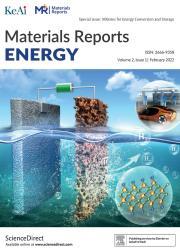Optimization strategies for enhancing the stability of Cu-based catalysts
IF 13.8
引用次数: 0
Abstract
Electrocatalytic carbon dioxide reduction (ECO2RR) serves as a promising approach for converting CO2 into energy-dense fuels and high-value chemicals, garnering substantial interest across academic and industrial sectors. Copper (Cu)-based electrocatalysts are widely acknowledged as highly effective for ECO2RR, primarily due to their optimal adsorption energy for ∗CO. Nonetheless, significant challenges remain to be addressed in transitioning Cu-based catalysts from research settings to industrial applications, including the low stability and unavoidable side reactions. This article aims to i) systematically examine the deactivation mechanisms of Cu-based catalysts, including changes in valence states, surface poisoning, and restructuring (agglomeration, dissolution, Ostwald ripening); ii) provide a timely overview of cutting-edge strategies to enhance the stability of Cu-based catalysts, such as ligand effects, heteroatom doping, support optimization, size effect, and restructuring; iii) highlight critical areas and prospective development directions that warrant further exploration to expedite the industrial adoption of Cu-based catalysts in ECO2RR.

提高铜基催化剂稳定性的优化策略
电催化二氧化碳还原(ECO2RR)是将二氧化碳转化为高能量燃料和高价值化学品的一种很有前途的方法,引起了学术界和工业界的极大兴趣。铜基电催化剂被广泛认为是高效的ECO2RR催化剂,主要是由于其对∗CO的最佳吸附能。然而,将铜基催化剂从研究环境转变为工业应用仍然面临重大挑战,包括低稳定性和不可避免的副反应。本文旨在1)系统地研究cu基催化剂的失活机制,包括价态变化、表面中毒和重组(团聚、溶解、奥斯特瓦尔德成熟);ii)及时概述了提高cu基催化剂稳定性的前沿策略,如配体效应、杂原子掺杂、载体优化、尺寸效应和重组;iii)强调需要进一步探索的关键领域和未来发展方向,以加快铜基催化剂在ECO2RR中的工业应用。
本文章由计算机程序翻译,如有差异,请以英文原文为准。
求助全文
约1分钟内获得全文
求助全文
来源期刊

材料导报:能源(英文)
Renewable Energy, Sustainability and the Environment, Nanotechnology
CiteScore
13.00
自引率
0.00%
发文量
0
审稿时长
50 days
 求助内容:
求助内容: 应助结果提醒方式:
应助结果提醒方式:


